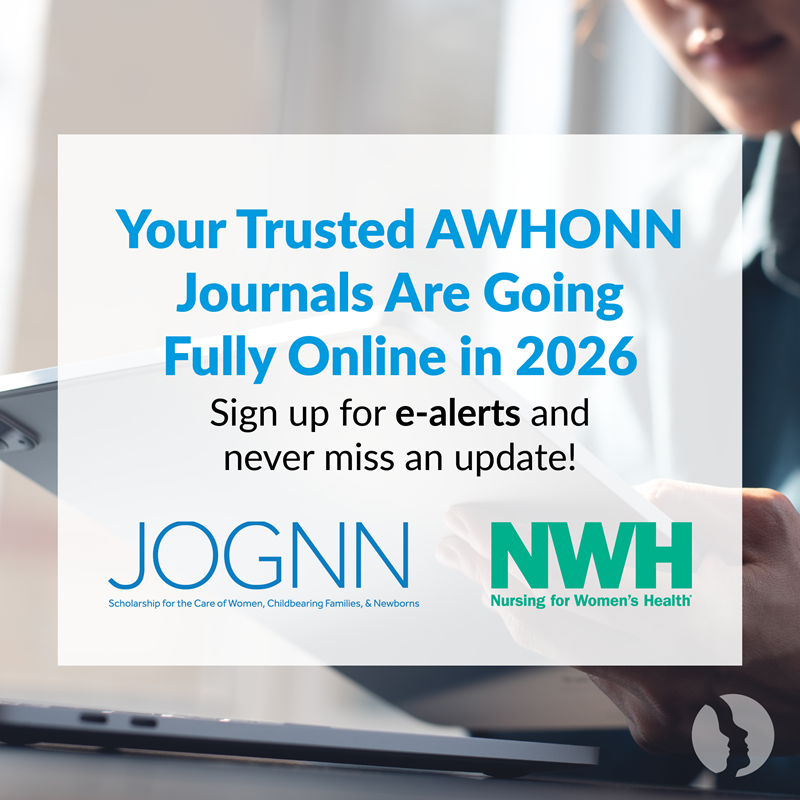Patient Safety Resources
- Magnet Template: POST BIRTH Warning Signs
POST-BIRTH Magnet template for hospitals. Magnet template can be downloaded, a hospital logo can be added, and magnets can be printed. Templates are available in English, Spanish, Arabic, Mandarin Chinese, and Haitian Creole. - Maternal Fetal Triage Index (MFTI) Toolkit
AWHONN has developed the MFTI toolkit for hospital purchasers. The MFTI Toolkit has the resources that you need to implement the Maternal Fetal Triage Index in your unit. - Guidelines for Professional Registered Nurse Staffing for Perinatal Units
Promote quality care by planning nurse staffing for your perinatal unit based on Guidelines for Professional Registered Nurse Staffing for Perinatal Units from the leading authority in perinatal nursing: AWHONN. -
Standards for Professional Nursing Practice- 8th Ed.
Adopted by nurses and healthcare organizations worldwide these expert developed and reviewed benchmarks are the standards for nursing care of women and newborns. The AWHONN Standards summarize the specialty’s core principles of nursing practice. - Respectful Maternity Care Implementation Toolkit
The Respectful Maternity Care Implementation Toolkit provides you with the tools and resources you need to implement the 10-Step “C.A.R.E. P.A.A.T.T.H.” within your organization. Make the commitment today to provide Respectful Maternity Care to every patient, every interaction, every time! - Respectful Maternity Care Framework and Evidence-Based Guideline
The Respectful Maternity Care Framework and Evidence-Based Clinical Practice Guideline provides evidence-based approaches to support the implementation of RMC processes. - AWHONN SBARs
AWHONN SBARs explores racial bias and offers ideas on how to implement small changes that have a big impact.
- Using Scorecard Feedback to Improve Quantitative Blood Loss Measurement at Birth
Objective: To increase the percentage of cases in which quantitative blood loss (QBL) was documented by labor and delivery nurses for women giving birth. - Educating Parents on Vitamin K Prophylaxis for Newborns
Nurses often administer the newborn vitamin K injection, and they play a key role in educating parents and helping them make informed decisions about vitamin K prophylaxis for their newborns.
-
POST-BIRTH Warning Signs Online Education Course
AWHONN’s Post-Birth Warning Signs online education course provides a standard approach to postpartum pre-and post-discharge education for all women, regardless of risk factors. This course is designed to educate nurses and other obstetric care providers about the maternal morbidity and mortality crisis in the U.S., particularly in the postpartum period. -
Maternal Fetal Triage Index (MFTI) Education
The Maternal Fetal Triage Index (MFTI) educational module educates perinatal nurses about obstetric triage basics—what triage means in obstetrics, what the nurses’ role is, and how a systematic approach can be beneficial to improve the process of triage and outcomes. This interactive learning module introduces AWHONN’s new Maternal Fetal Triage Index, a five-level acuity classification index, describing how it is used to prioritize a woman’s urgency for provider evaluation. Clinical cases throughout the module and in the posttest assist the nurse to apply the concepts presented to prioritize the cases. -
Mothers and Babies First (Relias): OB Hemorrhage
RELIAS OB NOW REVIEWED AND VALIDATED BY AWHONN.
- The Role of Unlicensed Assistive Personnel (Nursing Assistive Personnel) in the Care of Women and Newborns
- Rights and Responsibilities of Nurses Related to Reproductive Health Care
- Intimate Partner Violence
- Marijuana Use During Pregnancy
- Role of the Registered Nurse in the Care of the Pregnant Woman Receiving Analgesia and Anesthesia by Catheter Techniques
- The Use of Chaperones during Sensitive Examinations and Treatments
- Human Trafficking
- Breastfeeding Recommendations for Women Who Receive Medication-Assisted Treatment for Opioid Use Disorders: AWHONN Practice Brief Number 4
- Immediate and Sustained Skin-to-Skin Contact for the Healthy Term Newborn After Birth: AWHONN Practice Brief Number 5
- Use of Nitrous Oxide in Maternity Care: AWHONN Practice Brief Number 6
- Standardized Practices to Address Maternal Venous Thromboembolism: AWHONN Practice Brief Number 7
- Sudden Unexpected Postnatal Collapse in Healthy Term Newborns: AWHONN Practice Brief Number 8
- Prevention of Newborn Falls/Drops in the Hospital: AWHONN Practice Brief Number 9
- Maternal and Newborn Safety During the Administration of Brexanolone: AWHONN Practice Brief Number 10
- Lower Extremity Nerve Injury in Childbirth: AWHONN Practice Brief Number 11
- Obstetric Patient Safety: OB Emergencies Workshop
Obstetric emergencies are high-acuity, low-frequency events. Despite efforts from many collaborating agencies and professional organizations, the maternal mortality rate in the United States continues to remain high. The prerequisite on-line courses are designed to help you identify, assess, and manage women with specific obstetric emergencies such as hypertensive disorders of pregnancy, postpartum hemorrhage, and maternal sepsis. - Advanced Fetal Monitoring Course, 5th Ed
AWHONN’s advanced fetal heart monitoring course is designed for perinatal clinicians who previously completed the AWHONN Intermediate Fetal Monitoring Course, a comparable fetal monitoring educational program and/or who hold certification or added credentials in fetal heart monitoring. It may be used to support preparation for certification examinations.























